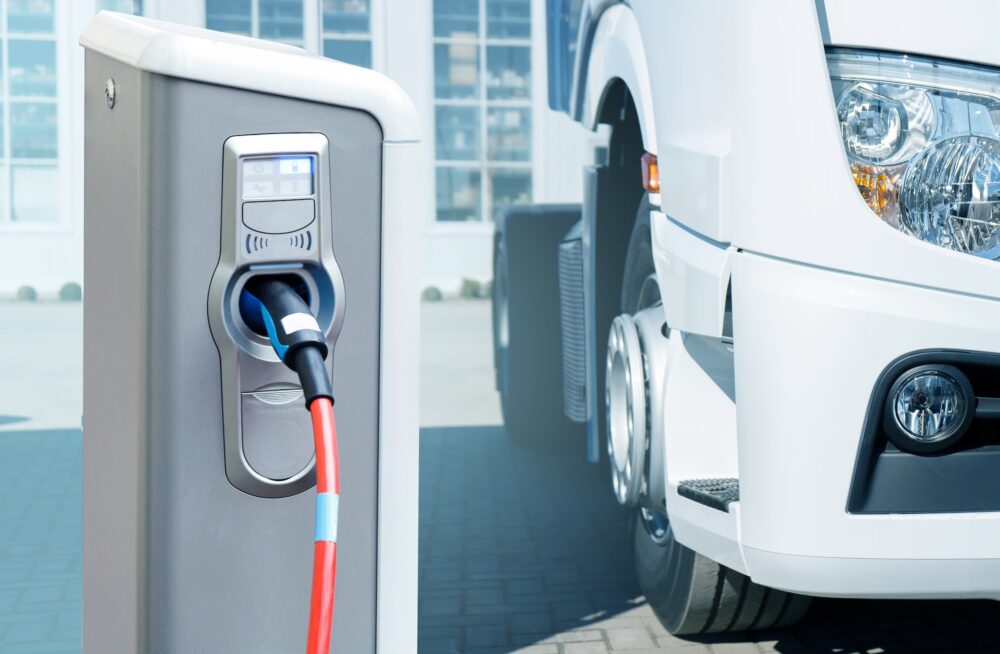Complimentary ACF Risk Assessment
If you’d like to spend more time on your fleet and less time worrying about compliance pathways, GVWR ratings, and ZEV powertrains, our experts can help develop a customized compliance roadmap for your organization.
Learn How to Save on ACF Compliance

What is
Advanced Clean Fleets?
The Advanced Clean Fleets (ACF) regulation is a policy initiative aimed at accelerating the transition of medium- and heavy-duty vehicles to zero-emissions by 2045 in the state of California. Enacted by the California Air Resources Board (CARB), this regulation mandates fleet operators to gradually increase the adoption of zero-emission vehicles (ZEVs) over time. The goal is to reduce greenhouse gas emissions, improve air quality, and promote sustainable transportation solutions.
CARB is a regulatory agency responsible for protecting and improving air quality in California. Established in 1967, CARB is part of the California Environmental Protection Agency (CalEPA) and is empowered to enact and enforce regulations to reduce air pollution from motor vehicles, industries, and other sources. CARB’s initiatives include setting emission standards, promoting cleaner technologies, and implementing programs to achieve significant greenhouse gas reductions and air quality improvements statewide. As a pioneer in environmental regulations, CARB often sets precedents that influence national and global environmental policy, particularly in areas like vehicle emissions and climate change mitigation.
CARB estimates that ACF can lead to a reduction in emissions of nearly 25 million metric tons of CO2 between 2024 and 2041.
HVIP Funding is the Modern-Day Gold Rush
Non-compliance can result in fines of up to $10,000 per vehicle, per day. Can your fleet afford the risk?
$350M
150+
$240k

Go Beyond ACF Compliance:
Fleet Electrification Made Easy
ACF compliance is critical for organizations based in California and surrounding states, but that’s only a small part of the equation. As an end-to-end fleet management company (FMC) that works exclusively with electric vehicles (eFMC™), partnering with Inspiration includes access to all traditional FMC services — plus innovative new services specifically designed around the unique attributes and capabilities of electric vehicles.
No matter where you are on your electrification journey, our EV-first fleet products and services are designed to accelerate the growth of EVs in your fleet while continuing to support the gas and diesel vehicles not yet ready to electrify.
Charging is key to any successful EV transition: when and where each vehicle will charge and how much it will cost, including both the upfront investment and the price of fuel. We’ve got you covered with support for every type of charging you might need.
Frequently Asked Questions
What Fleets are Impacted by the ACF Regulation?
CARB designed ACF to transition the following fleet types to ZEVs:
- Drayage fleets with trucks that operate in CA ports or intermodal rail yards
- State and local government fleets that run medium- and heavy-duty vehicles
- High priority private and federal fleets that run either 50 or more vehicles above an 8,500 GVWR or earn $50 million or more in annual revenue
Note: If your fleet primarily operates outside of California, meets the above requirements, and has even a single vehicle travel in or through California, that vehicle will be subject to the ACF regulation.
What are the ACF Compliance Requirements?
- Drayage Fleets
- Beginning January 1, 2024, all drayage trucks registering for the first time with CARB must be powered with a zero-emission powertrain
- Trucks over 12 years old must have mileage reported by 2025
- Trucks must be taken out of service at end of life: 18 years or 800,000 miles
- All fleet trucks must be ZEVs by 2035, regardless of vehicle age or mileage
- State and Local Government Fleets
- Beginning January 1, 2024, 50% additions to fleet in each calendar year must be ZEV medium- and heavy-duty vehicles
- All new vehicle purchases must be ZEVs starting in 2027
- High Priority Private and Federal Fleets
- Beginning January 1, 2024, with an initial report due February 1, 2024, fleets have two pathways for compliance beginning in 2025:
- PATHWAY 1 – MODEL YEAR SCHEDULE TIMELINE
- As of January 1, 2024, fleets must only purchase ZEV or NZEV and remove ICE at end of life (18 years or 800k miles). Registration of all vehicles starts Jan. 2024 in the TRUCRS system.
- PATHWAY 2 – ZERO-EMISSION MILESTONE TIMELINE
- ZEV percentage milestones as determined by preset vehicle groups. Registration of all vehicles starts Jan. 2024 in the TRUCRS system with baseline due Feb. 2024. Fleets can add ICE vehicles to their fleet if ZEV percentage milestones are hit.
In a Mixed Fleet, Which Vehicles are Impacted by ACF?
If fleets run 50+ vehicles that are 8,500 lbs. GVWR, they will need to adhere to the regulation. Light duty vehicles in class 1-2a are not currently part of this regulation. Even if you don’t run medium- or heavy-duty trucks, your fleet might fall under ACF regulation if you have light-duty package delivery vehicles or yard tractors.
Example: If a fleet has 50 or more Silverado 2500, Ford F-250, RAM 2500, Chevrolet Express, Mercedes-Benz Sprinter, RAM ProMaster, or Transit 150 models on the road, they will need to comply. Delivery trucks are also impacted by ACF, even if they are under 8,500 lbs. GVWR.
How Does ACF Work for Fleets Across Multiple States?
If a fleet runs a minimum of 50 vehicles with an 8,500 lbs. GVWR or earns more than $50 million in annual revenue, any vehicles operating in or through the state of California need to comply.
Example: A furniture manufacturer headquartered in Nevada, does occasional deliveries in California. They have a fleet of 75 box trucks, but only 10 enter California on a regular basis. Those 10 will need to meet specific ACF compliance and reporting requirements.
Why has CARB Suspended ACF Reporting for Certain Fleet Types?
Under the federal Clean Air Act (CAA), California-specific environmental regulations often require an EPA approved waiver to allow California to impose environmental restrictions and mandates that go beyond federal law.
CARB filed for a waiver in December 2023. While the EPA comes to their decision, reporting and enforcement has been suspended for high priority private, drayage, and federal fleets.
When is the Best Time to Acquire Vehicles for ACF Compliance?
With the potential of retroactive reporting, fleets should start getting ACF compliant as soon as possible. If a fleet wants to take advantage of HVIP voucher funding toward their ACF purchases, these orders must be placed before 2025 – and ideally before October 2024. Vehicle OEMs generally take one-to-two months to process orders, so waiting till December might not be enough time to secure the VIN information you need.
Can Fleets File Extensions or Exemptions?
CARB offers fleets some flexibility on ACF compliance if they fall into one of these four categories:
- Infrastructure delays: If construction delays an ACF compliance project, fleets may apply for a one-year extension before they must start to comply.
- Electrical delays: If your utility provider needs more time to make electrical upgrades, the fleet may delay ZEV adoption. This extension type will close out in 2030.
- Vehicle delivery delays: If your vehicles experience a delivery delay, your fleet may file for an extension to continue using your ICE vehicles until ZEV delivery.
- Daily usage exemptions: If an organization can prove that available ZEV models do not meet their operational requirements, an exemption can be requested.
For state and local government fleets, specific counties or agencies with less than 10 medium- or heavy-duty vehicles are exempt until further notice.
Will Other States Implement ACF?
ACF is starting in California, but other states are likely to follow suit. By reviewing the Advanced Clean Trucks (ACT) regulation, we can predict which states are likely to adopt ACF.
Those states include:
- Massachusetts
- New Jersey
- New York
- Oregon
- Washington
- Vermont
- Colorado
- Maryland
- New Mexico
- Rhode Island
What Vehicles Should Fleets Add to Become Complaint?
There are ACF-complaint solutions for just about any vehicle type on the market.
Vehicle Types
- Box Trucks
- Cargo Vans
- Delivery Vans
- Heavy-Duty Trucks
- Medium-Duty Trucks
- Pickup Trucks
Vehicle OEMS
- Ford
- Mercedes-Benz
- RAM
- Rivian
- XOS
- And more!
What is the HVIP Voucher?
The Clean Truck & Bus Vouchers (HVIP) is a program set up by CARB to accelerate market transformation by incentivizing the purchase of zero-emission heavy-duty trucks and buses for California fleets. HVIP is the cornerstone of advanced technology heavy-duty incentives, providing funding since 2010 to support the long-term transition to ZEVs in the heavy-duty market, as well as supporting investments in other emerging technologies to achieve substantial GHG reductions and help meet health-based ambient air quality standards. Investments made through HVIP provide both broad purchase incentives for fleets, and more targeted measures to address air quality needs in California’s priority populations.
Get a Complimentary ACF Risk Assessment
Still unsure if or how ACF will impact your fleet? Our experts will assess your fleet to let you know if you’ll need to conform to the new regulation and how much you can save by going electric.


